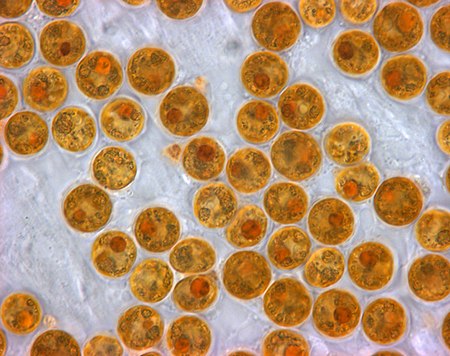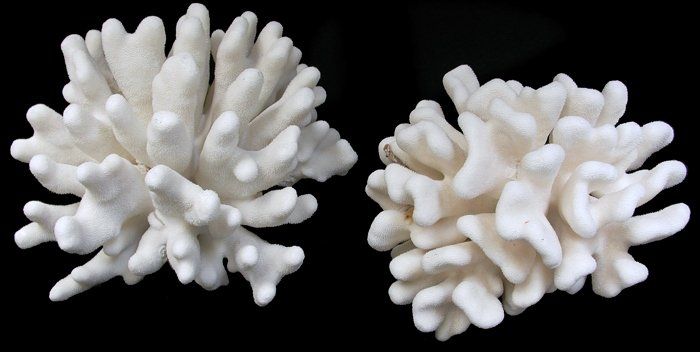A 7 to 9" Elkhorn Coral cluster OUT OF STOCK
An Elkhorn Coral cluster measuring 11 to 13 inches.
Orders usually process within 2 to 5 business days.
Make Your Selections and Shipping Preference. We Will Email You the amount of the Shipping Cost. When you receive the shipping cost go back into Shells-of-Aquarius.company and click into Purchase Shipping Label. There you will find UPS or USPS. Click into the option you decided on and make your payment. Your order will ship when shipping payment is received.
Email: ja1@mindspring.com
Elkhorn coral is an important reef-building coral in the Caribbean. The species has a complex structure with many branches which resemble that of elk antlers; hence, the common name. The branching structure creates habitat and shelter for many other reef species. Elkhorn coral is known to grow quickly with an average growth rate of 2.0 to 4 inches per year. They can reproduce both sexually and asexually, though asexual reproduction is much more common and occurs through a process called fragmentation.
Fragmentation in multicellular or colonial organisms is a form of asexual reproduction or cloning, where an organism is split into fragments upon maturation and the separated part becomes the new individual.
Although Elkhorn coral dominated the Caribbean in the early 1980s, the species has since dramatically declined in numbers. Scientists have estimated that between 1980 and 2006, when it was listed in the Endangered Species Act (ESA), the population declined by around 97%. This decline was due to a variety of factors, including disease, algae growth, climate change, ocean acidification, and human activity. In May 2006, Elkhorn coral was officially listed as threatened in the ESA along with another species in the Acropora genus, staghorn coral. Some conservation efforts are now in place to protect the species and promote increased genetic variability among the species.
Ocean acidification is the ongoing decrease in the pH of the Earth's ocean. Over the past 200 years, the rapid increase in anthropogenic CO2 (carbon dioxide) production has led to an increase in the acidity of the Earth’s oceans. Between 1950 and 2020, the average pH of the ocean surface fell from approximately 8.15 to 8.05.[2] Carbon dioxide emissions from human activities are the primary cause of ocean acidification, with atmospheric carbon dioxide (CO2) levels exceeding 410 ppm (in 2020). CO2 from the atmosphere is absorbed by the oceans. This chemical reaction produces carbonic acid (H2CO3) which dissociates into a bicarbonate ion (HCO−3) and a hydrogen ion (H+). The presence of free hydrogen ions (H+) lowers the pH of the ocean, increasing acidity (this does not mean that seawater is acidic yet; it is still alkaline, with a pH higher than 8). Marine calcifying organisms, such as mollusks and corals, are especially vulnerable because they rely on calcium carbonate to build shells and skeletons.
Elkhorn coral produce hard antler-like structures composed of calcium carbonate. These structures can be up to 6 feet high and 43 feet wide. Healthy Elkhorn coral are a dull, brownish-yellow color.
Elkhorn coral's primary source of food comes from photosynthetic algae, zooxanthellae, that live inside the coral's cells.[4] Therefore, Elkhorn coral are highly dependent on the sunlight for sustenance, leaving Elkhorn coral vulnerable to increased turbidity or water clarity. During bleaching events, or long-term periods of increased turbidity, Elkhorn coral can obtain nourishment from alternative food sources through filter feeding.
Zooxanthellae are photosynthetic organisms, which contain chlorophyll a and chlorophyll c, as well as the dinoflagellate pigments peridinin and diadinoxanthin. These provide the yellowish and brownish colours typical of many of the host species. During the day, they provide their host with the organic carbon products of photosynthesis, sometimes providing up to 90% of their host's energy needs for metabolism, growth and reproduction. In return, they receive nutrients, carbon dioxide, and an elevated position with access to sunshine.
Elkhorn coral have special algae living in their tissues known as zooxanthellae. Zoothanthellae meet their nutritional requirements using photosynthesis, a process that converts carbon dioxide and water into sugars and oxygen. Elkhorn coral provide habitat for these algae and, in turn, receive an abundant source of oxygen, enabling them to grow quickly.

Brownish-Yellow Zooxanthellae image
Elkhorn coral's primary source of nutrients comes from photosynthetic algae, zooxanthellae, that live inside the coral's cells.Therefore, Elkhorn coral are highly dependent on the sunlight for sustenance, leaving Elkhorn coral vulnerable to increased turbidity or water clarity. During bleaching events, or long-term periods of increased turbidity, Elkhorn coral can obtain nourishment from alternative food sources through filter feeding.
Elkhorn coral can also use filter feeding techniques to obtain food. At night, Elkhorn coral use their tentacles to snatch free-swimming zooplankton from the water. Zooplankton complete daily diel migrations. In the morning, zooplankton sink to the depths of the ocean where predators are scarce, and then come nightfall, they rise back towards the surface. By concentrating their predation activities at night, Elkhorn coral expend less energy catching large amounts of prey. However, because filter feeding is more energy intensive than relying on zooxanthellae, Elkhorn coral will only resort to this feeding method when water conditions are poor and block out sunlight.
Elkhorn coral live in shallow habitats, which give them abundant access to light. Elkhorn coral requires oxygen to survive, most of which they obtain through special, photosynthetic algae living in their tissues called zooxanthellae. In order to help zooxanthellae produce as much oxygen as possible, Elkhorn coral live in shallow regions between 3 to 16 feet deep to ensure that abundant light reaches the zooxanthellae, maximizing photosynthesis.
Elkhorn corals are found in clear, shallow water throughout the Bahamas, Florida, the Caribbean, and beyond to the northern shores of Venezuela. Broward County Florida is the most north point they have been found. Elkhorn coral thrive best in high-energy zones where wave action is frequent; which increases the likely hood of fragmentation, resulting in more new colonies to form.
Due to fragmentation and rapid growth rates, Elkhorn coral were the primary foundation in the development of the Caribbean coral reefs. Over the last 5,000 years, Elkhorn coral, Staghorn coral, and Star coral comprised the southeastern reefs. Research has shown that the Elkhorn coral evolved during the Mid-Pliocene epoch, 5.2-2.58 million years ago. The unstable climate during this period allowed Elkhorn coral to thrive during glacial and interglacial events. During glacial events, sea levels rise and cause an increase in wave energy. As previously mentioned, Elkhorn coral does best in environments that are shallow and experience high energy changes, which aid in the reproductive process.
Resembling the foundation of a house, Elkhorn coral support coral reef communities. Their interwoven lattice-like branches create a variety of habitats varying in topography, which in turn, support diverse fish populations. These habitats support fish nurseries and protect fish from predators, increasing reef diversity. This elevated diversity makes the reefs more appealing to tourists, thereby increasing their economic value.
Elkhorn coral create thick, interlocking groups known as thickets. Thickets provide shelter to other marine life such as fish, crustaceans, and marine invertebrates, and consist of many identical polyps that have grown together. These dense groups provide protection to shorelines against large waves and storms.
The Elkhorn coral is a simultaneous hermaphrodite, meaning that in each coral colony both egg and sperm are produced. Despite this, self-fertilization usually does not occur. In order for successful fertilization to take place, two genetically distinct parents are needed. Successful reproduction rates are low in Elkhorn coral which limit the growth of new colonies. The probability of successful reproduction rates are low in Elkhorn coral because only about 50% of Elkhorn corals are genetically unique individuals. The Elkhorn coral reproduction cycle occurs once per year, after a full moon in the late summer, during the months of either July, August, or September. The gametes are released for only a few nights by broadcast spawning eggs and sperm into a water column. Once fertilized, the eggs develop into larvae that settle on hard surfaces and begin the growth of a new colony. Elkhorn coral colonies live for centuries. These coloni grow between 2 to 4 inches each year, reaching maximum size in 10 to 12 years.
Elkhorn coral are threatened by climate change. Climate change refers to the general warming of earth's average temperature caused by carbon emissions. Warmer atmospheric temperatures incidentally also increase water temperature. Elkhorn coral have special algae called zooxanthellae, living on their tissues, which provide many benefits. When water temperatures warm, Elkhorn coral expel their zooxanthellae. Without their zooxanthellae, Elkhorn coral first lose their prime oxygen source, then color, and then usually die. Climate change increases the severity and prevalence of storms, which can decimate Elkhorn coral populations. Elkhorn coral are currently listed as critically endangered.
Scientific classification
Domain: Eukaryota
Kingdom: Animalia
Phylum: Cnidaria
Class: Hexacorallia
Order: Scleractinia
Family: Acroporidae
Genus: Acropora
Species: Acropora palmata
Binomial name: Acropora palmata
Lamarck, 1816
(REF: Aronson, R.; Bruckner, A.; Moore, J.; Precht, B.; E. Weil. (2008). "Acropora palmata". IUCN Red List of Threatened Species. 2008:)(REF: WoRMS (2010). "Acropora palmata (Lamarck, 1816)". WoRMS. World Register of Marine Species. Retrieved December2011.)(REF: Crabtree, R. E (2014). Endangered Species Act - Section 7 Consultation Biological Opinion. United States Corps of Engineers)(REF: Fisheries, NOAA (December 30, 2019). "Elkhorn Coral | NOAA Fisheries". NOAA. Retrieved April 2020)(REF: "Welcome to the NOAA Institutional Repository |". repository.library.noaa.gov. Retrieved April 14, 2020.)(REF: "Endangered and Threatened Species; Critical Habitat for Threatened Elkhorn and Staghorn Corals". Federal Register. November 2008. Retrieved April 2020)(REF: Ferrario, Filippo; Beck, Michael W.; Storlazzi, Curt D.; Micheli, Fiorenza; Shepard, Christine C.; Airoldi, Laura (May 13, 2014). "The effectiveness of coral reefs for coastal hazard risk reduction and adaptation". Nature Communications. 5)(REF: Fisheries, NOAA (December 2019). "Critical Habitat for Elkhorn and Staghorn Corals | NOAA Fisheries". NOAA. Retrieved April 2020.)(REF: Hernandez-Delgado (January 2010). "Sediment Stress, Water Turbidity, and Sewage Impacts on Threatened Elkhorn Coral (Acropora palmata) Stands at Vega Baja, Puerto Rico". Proceedings of the 63rd Gulf and Caribbean Fisheries Institute. 63)(REF: "Endangered and Threatened Species; Availability of the Final Recovery Plan for Staghorn and Elkhorn Corals". Federal Register. March 2015. Retrieved April 2020.)(REF: NOAA Fisheries Species Directory - Elkhorn Coral (Acropora palmata)
